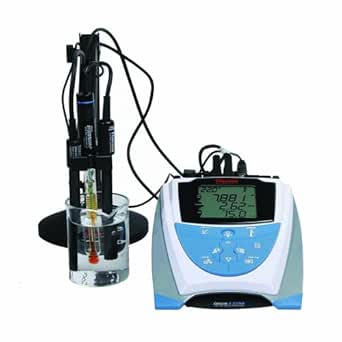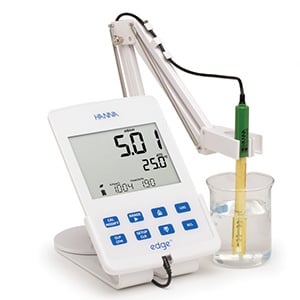EECS 143 Microfabrication Technology. What Are Resistivity and Conductivity Units? How to convert them? Conductivity, Salinity & Total Dissolved Solids - Environmental conductivity probe hannanorden sensors larger Conductivity measurement is widely used for quality control purposes. Conductivity (electrolytic) - Wikipedia
 This is accomplished by using a second pair of electrodes.
This is accomplished by using a second pair of electrodes. measure conductivity Conductivity Measurement: Critical for Clean Group of answer choices. 4 electrode (4-pole) conductivity sensors function in a much the same way as 2 electrode sensors however they offer a much larger measurement range. Four point probe is used to measure resistive properties of semiconductor wafers and thin films. Four Ring Probes Four ring probe conductivity (four ring conductivity) utilizes a potentiometric approach to taking a measurement; an alternating current is applied to the outer two driveelectrodes to induce a current in the solution.

 conductivity ph measuring devices meter hach probe The conductivity guide helps build essential theoretical concepts in an easy-to-understand language. The drop in voltage caused by the resistance of the water is used to calculate the conductivity per centimeter. Electrodes are placed in the sample 2. When nutrients dissolve in water, they split into ions.
conductivity ph measuring devices meter hach probe The conductivity guide helps build essential theoretical concepts in an easy-to-understand language. The drop in voltage caused by the resistance of the water is used to calculate the conductivity per centimeter. Electrodes are placed in the sample 2. When nutrients dissolve in water, they split into ions.  Conductivity Conductivity Measurement Theory Guide | METTLER Solved What does the conductivity probe do? Group of | Chegg.com The measurement unit for electrical conductivity is called Siemens(S) (E.g. Basics of Conductivity Measurement - Instrumentation and Control With conductivity you measure the electrical conductivity of the fluid. 1.
Conductivity Conductivity Measurement Theory Guide | METTLER Solved What does the conductivity probe do? Group of | Chegg.com The measurement unit for electrical conductivity is called Siemens(S) (E.g. Basics of Conductivity Measurement - Instrumentation and Control With conductivity you measure the electrical conductivity of the fluid. 1. In fact, a rule of thumb is that there is a 2% increase in conductivity for every 1oC change in temperature. As the water or solution is being measured, both resistance|conductance and temperature are being measured.
The most common range when measuring conductivity is between 0.05 micro-Siemens (mS / cm) to 200 milli Siemens (mS / cm). Equipment. These probes have a limited range, therefore you would have a dedicated probe/meter for each range. What are Toroidal Conductivity Sensors and How Do They Work? conductivity Product Recommendations. Applications for electrical conductivity measurement include boiler water treatment, cooling tower water treatment, and reverse osmosis monitoring. The probes have sensors on the end that read the conductivity. As you can see in the image, the voltage for the batteries is being shown as 4.5V. Conductivity is an inherent property of any given solution and is derived from conductance by the geometry of the measuring cell. The units we use to measure EC are Siemens/cm (S/cm, mS/cm, S/cm, dS/m). Conductivity Flashcards measure conductivity Conductivity measures the ability of a solution to conduct an electric current between two electrodes. Electrical current flows between two electrodes within the probe set at various distances from each other. This is accomplished by using a second pair of electrodes.

 The Vernier Conductivity Probe measures the ability of a solution to conduct an electric current between two electrodes. Conductivity is measured with a probe and a meter. Measuring Conductivity - Biomedx Four ring probe conductivity (four ring conductivity) utilizes a potentiometric approach to taking a measurement; an alternating current is applied to the outer two driveelectrodes to induce a current in the solution. The voltage is measured between the inner pair of electrodes in solution. It gives scientists a precise and comprehensive charting of the distribution and variation of water temperature, salinity, and density that helps to understand how the oceans affect life. Four-Point Probe Manual This second pair of electrodes produce a known current which allows for measurement of the voltage drop across the electrodes. It can measure either bulk or thin film specimen, each of which consists of a different expression. In Part I of the experiment, you will measure the specific heat of aluminum, copper Identification of an Unknown Metal.
The Vernier Conductivity Probe measures the ability of a solution to conduct an electric current between two electrodes. Conductivity is measured with a probe and a meter. Measuring Conductivity - Biomedx Four ring probe conductivity (four ring conductivity) utilizes a potentiometric approach to taking a measurement; an alternating current is applied to the outer two driveelectrodes to induce a current in the solution. The voltage is measured between the inner pair of electrodes in solution. It gives scientists a precise and comprehensive charting of the distribution and variation of water temperature, salinity, and density that helps to understand how the oceans affect life. Four-Point Probe Manual This second pair of electrodes produce a known current which allows for measurement of the voltage drop across the electrodes. It can measure either bulk or thin film specimen, each of which consists of a different expression. In Part I of the experiment, you will measure the specific heat of aluminum, copper Identification of an Unknown Metal. What are the different conductivity scales? What do they mean? Conductivity is a measure of the ability of water to pass an electrical current. Toroidal conductivity consists of a reception coil and a transmission coil, which work together to identify how conductive the solution is. Measures the change in conductivity due to the increase of sugar in the water. Conductivity measurement
 How does a pH and conductivity meter work? - Instrument Choice Product Recommendations. Conductivity Meter Operation & Use. Conductivity is also affected by temperature: the warmer the When water contains these ions it will conduct electricity, such as from a lightning bolt or a wire from the wall socket, as the electricity from the source will seek out oppositely-charged ions in the water. 4 electrode (4-pole) conductivity sensors function in a much the same way as 2 electrode sensors however they offer a much larger measurement range. conductivity measurement sensors manufacturing process electrodeless measures purity conductivity meter water latest pH is a measure of the acidity of water or soil and is based specifically on its hydrogen ion concentration. conductivity prinsip with a concentration measurement can be outlined: 1. Once the EC is determined, a conversion factor is ran (generally by the meter performing the measurement) to determine the TDS. Pure water will not conduct electricity. With the inductive conductivity, ISC40 series, one sensor can measure the full range of conductivity from 0-2000 mS/Cm. In practice, the conductivity meter measures the actual conductivity (e.g. What does a conductivity meter measure? - Answers
How does a pH and conductivity meter work? - Instrument Choice Product Recommendations. Conductivity Meter Operation & Use. Conductivity is also affected by temperature: the warmer the When water contains these ions it will conduct electricity, such as from a lightning bolt or a wire from the wall socket, as the electricity from the source will seek out oppositely-charged ions in the water. 4 electrode (4-pole) conductivity sensors function in a much the same way as 2 electrode sensors however they offer a much larger measurement range. conductivity measurement sensors manufacturing process electrodeless measures purity conductivity meter water latest pH is a measure of the acidity of water or soil and is based specifically on its hydrogen ion concentration. conductivity prinsip with a concentration measurement can be outlined: 1. Once the EC is determined, a conversion factor is ran (generally by the meter performing the measurement) to determine the TDS. Pure water will not conduct electricity. With the inductive conductivity, ISC40 series, one sensor can measure the full range of conductivity from 0-2000 mS/Cm. In practice, the conductivity meter measures the actual conductivity (e.g. What does a conductivity meter measure? - Answers  Because dissolved salts and other inorganic chemicals conduct electrical current, conductivity increases as salinity increases. The conductivity meter then uses the conductance and cell con-stant to display the conductivity. The ability of water to pass and electrical current. The ORP depends upon chloride ion (Cl-) and pH (H+) as much as it does hypochlorous acid (chlo-rine in water).
Because dissolved salts and other inorganic chemicals conduct electrical current, conductivity increases as salinity increases. The conductivity meter then uses the conductance and cell con-stant to display the conductivity. The ability of water to pass and electrical current. The ORP depends upon chloride ion (Cl-) and pH (H+) as much as it does hypochlorous acid (chlo-rine in water).  The conductivity, pH and concentration of the ammonia in solution are all directly related. conductivity meter hanna ms cc haines All have durable epoxy bodies. Electrical conductivity is the measure of the concentration of ions present within a sample. The measuring range for the instrument is established by calibration. Conductivity and total dissolved solids (TDS) meters come with one sensor that takes both chemistry measurements. Conductivity, salinity, and total dissolved solids (TDS) meters come with one sensor that takes all three chemistry measurements. 5.9 Conductivity | Monitoring & Assessment | US EPA For monitoring and controlling of used water, conductivity is one of the important, cost-effective and stable parameter. Conductivity
The conductivity, pH and concentration of the ammonia in solution are all directly related. conductivity meter hanna ms cc haines All have durable epoxy bodies. Electrical conductivity is the measure of the concentration of ions present within a sample. The measuring range for the instrument is established by calibration. Conductivity and total dissolved solids (TDS) meters come with one sensor that takes both chemistry measurements. Conductivity, salinity, and total dissolved solids (TDS) meters come with one sensor that takes all three chemistry measurements. 5.9 Conductivity | Monitoring & Assessment | US EPA For monitoring and controlling of used water, conductivity is one of the important, cost-effective and stable parameter. Conductivity